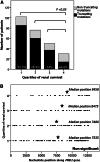Type of PKD1 mutation influences renal outcome in ADPKD
- PMID: 23431072
- PMCID: PMC3665389
- DOI: 10.1681/ASN.2012070650
Type of PKD1 mutation influences renal outcome in ADPKD
Abstract
Autosomal dominant polycystic kidney disease (ADPKD) is heterogeneous with regard to genic and allelic heterogeneity, as well as phenotypic variability. The genotype-phenotype relationship in ADPKD is not completely understood. Here, we studied 741 patients with ADPKD from 519 pedigrees in the Genkyst cohort and confirmed that renal survival associated with PKD2 mutations was approximately 20 years longer than that associated with PKD1 mutations. The median age at onset of ESRD was 58 years for PKD1 carriers and 79 years for PKD2 carriers. Regarding the allelic effect on phenotype, in contrast to previous studies, we found that the type of PKD1 mutation, but not its position, correlated strongly with renal survival. The median age at onset of ESRD was 55 years for carriers of a truncating mutation and 67 years for carriers of a nontruncating mutation. This observation allows the integration of genic and allelic effects into a single scheme, which may have prognostic value.
Figures


Comment in
-
The mutation, a key determinant of phenotype in ADPKD.J Am Soc Nephrol. 2013 May;24(6):868-70. doi: 10.1681/ASN.2013040417. Epub 2013 May 16. J Am Soc Nephrol. 2013. PMID: 23687354 No abstract available.
References
-
- Dalgaard OZ, Nørby S: Autosomal dominant polycystic kidney disease in the 1980’s. Clin Genet 36: 320–325, 1989 - PubMed
-
- The European Polycystic Kidney Disease Consortium : The polycystic kidney disease 1 gene encodes a 14 kb transcript and lies within a duplicated region on chromosome 16. Cell 77: 881–894, 1994 - PubMed
-
- Mochizuki T, Wu G, Hayashi T, Xenophontos SL, Veldhuisen B, Saris JJ, Reynolds DM, Cai Y, Gabow PA, Pierides A, Kimberling WJ, Breuning MH, Deltas CC, Peters DJ, Somlo S: PKD2, a gene for polycystic kidney disease that encodes an integral membrane protein. Science 272: 1339–1342, 1996 - PubMed
-
- Audrézet M-P, Cornec-Le Gall E, Chen J-M, Redon S, Quéré I, Creff J, Bénech C, Maestri S, Le Meur Y, Férec C: Autosomal dominant polycystic kidney disease: Comprehensive mutation analysis of PKD1 and PKD2 in 700 unrelated patients. Hum Mutat 33: 1239–1250, 2012 - PubMed
MeSH terms
Substances
LinkOut - more resources
Full Text Sources
Other Literature Sources
Medical
Miscellaneous

